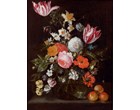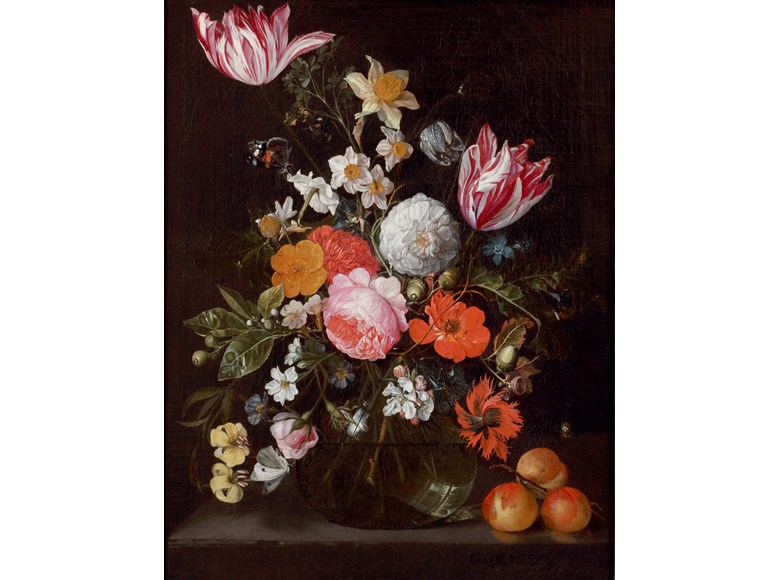 BACK TO GALLERY
BACK TO GALLERY
Lawrence Steigrad Fine Arts
Cornelis de Heem
Flowers in a Glass Vase on a Stone Ledge with Apricots
signed in the lower right C DE HEEM
21.4 x 16.7 inches (54.3 x 42.5 cm.)
description
Cornelis de Heem was the son of Jan Davidsz de Heem “the most highly esteemed still life painter of his day and for many years afterwards”, and from whom he received his training.[1] By 1660 Cornelis was a master in the Guild of Saint Luke in Antwerp. He married Catharina Pauwens and their eldest child was David Cornelisz de Heem. Naturally Cornelis’ work strongly reflected that of his father. He executed florals, fruit still lifes, bouquets, festoons, and as in this example paintings with flowers and fruit.[2]
David is also believed to have received his initial training from his grandfather Jan Davidsz, whose influence is evident in his earliest works, whereas his later works resemble those of his father Cornelis. Father and son often collaborated on the same painting and this painting is believed to date from circa 1680 – 1687. By 1693 David is recorded as an independent master of the Guild of St. Luke in Antwerp, specializing in flowers and fruit still lifes. Later he would move with his wife Anna Maria Cocq and their two sons to The Hague.[3] Mosigkau Castle, Dessau owns a collaborative work depicting Flowers in a Glass Vase by Cornelis and David, with another one a Garland of Fruit and Flowers in the Hofje van Aerden Museum, Leerdam, The Netherlands.
As in our painting the triangular form of the bouquet can be found in many of Cornelis’ flower paintings along with the dominating colors of white and red. Drawn to the bouquet in the upper left is a busy Garden Bumblebee, a recurring feature in Cornelis’ compositions. Butterflies flank the upper and lower corners of the left side, while in the lower right a spotted beetle descends towards the peaches. The uncommon addition of acorns further animates the floral arrangement’s three dimensionality. Another defining trait of Cornelis, his glass vases often have a kick (the inward shaped mound at the bottom), and almost always are placed on a stone slab with vertical grooves. As here, he signed his work with all capital letters with a loop underneath. When David worked alone his bouquets are rounder or more oval shaped, with the flower stems elongated and bent, but less twisted than in his father’s works.[4]
When this painting was auctioned at Sotheby’s in 1995 it bore a spurious signature and date of Jan Van Huysum ft 1737 in the lower left. In a subsequent cleaning this signature and date disappeared and Cornelis de Heem’s signature was revealed in the lower right.
We would like to thank Dr. Fred G. Meijer, after a recent firsthand inspection, for confirming again the painting to be a collaborative work by Cornelis de Heem and David Cornelisz de Heem.
[1] Sam Segal & Klara Alen, “Jan Davidsz de Heem” in Dutch and Flemish Flower Pieces, volume I, Brill, Hes & De Graaf, 2020, p. 378.
[2] Sam Segal & Klara Alen, “Cornelis de Heem”, op.cit., p. 387.
[3] Sam Segal & Klara Alen, “David Cornelis de Heem”, op.cit., p. 389.
[4] Sam Segal & Klara Alen, “Cornelis de Heem”, op.cit., pp. 387-388, and “David Cornelis de Heem”, op.cit., p. 389.
David is also believed to have received his initial training from his grandfather Jan Davidsz, whose influence is evident in his earliest works, whereas his later works resemble those of his father Cornelis. Father and son often collaborated on the same painting and this painting is believed to date from circa 1680 – 1687. By 1693 David is recorded as an independent master of the Guild of St. Luke in Antwerp, specializing in flowers and fruit still lifes. Later he would move with his wife Anna Maria Cocq and their two sons to The Hague.[3] Mosigkau Castle, Dessau owns a collaborative work depicting Flowers in a Glass Vase by Cornelis and David, with another one a Garland of Fruit and Flowers in the Hofje van Aerden Museum, Leerdam, The Netherlands.
As in our painting the triangular form of the bouquet can be found in many of Cornelis’ flower paintings along with the dominating colors of white and red. Drawn to the bouquet in the upper left is a busy Garden Bumblebee, a recurring feature in Cornelis’ compositions. Butterflies flank the upper and lower corners of the left side, while in the lower right a spotted beetle descends towards the peaches. The uncommon addition of acorns further animates the floral arrangement’s three dimensionality. Another defining trait of Cornelis, his glass vases often have a kick (the inward shaped mound at the bottom), and almost always are placed on a stone slab with vertical grooves. As here, he signed his work with all capital letters with a loop underneath. When David worked alone his bouquets are rounder or more oval shaped, with the flower stems elongated and bent, but less twisted than in his father’s works.[4]
When this painting was auctioned at Sotheby’s in 1995 it bore a spurious signature and date of Jan Van Huysum ft 1737 in the lower left. In a subsequent cleaning this signature and date disappeared and Cornelis de Heem’s signature was revealed in the lower right.
We would like to thank Dr. Fred G. Meijer, after a recent firsthand inspection, for confirming again the painting to be a collaborative work by Cornelis de Heem and David Cornelisz de Heem.
[1] Sam Segal & Klara Alen, “Jan Davidsz de Heem” in Dutch and Flemish Flower Pieces, volume I, Brill, Hes & De Graaf, 2020, p. 378.
[2] Sam Segal & Klara Alen, “Cornelis de Heem”, op.cit., p. 387.
[3] Sam Segal & Klara Alen, “David Cornelis de Heem”, op.cit., p. 389.
[4] Sam Segal & Klara Alen, “Cornelis de Heem”, op.cit., pp. 387-388, and “David Cornelis de Heem”, op.cit., p. 389.






 SEND AN EMAIL
SEND AN EMAIL
 (212) 517-3643
(212) 517-3643